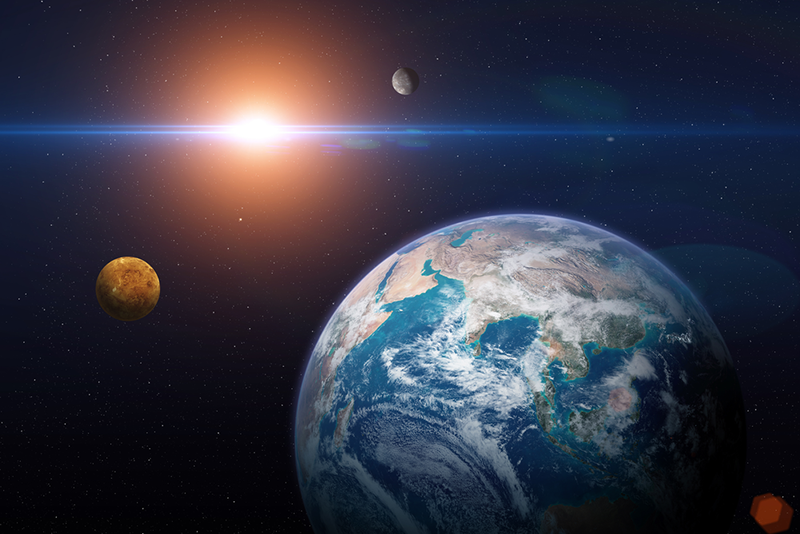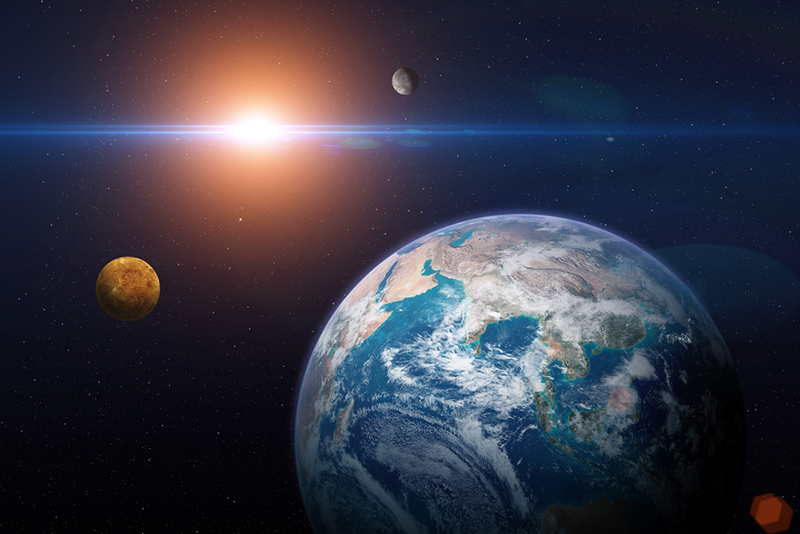A Pathway to Making Molecular Oxygen That Doesn’t Involve Life
So far, life is only known to exist on Earth. But that hasn’t stopped scientists from searching for signs of living creatures on other planets. Those searches intensified with the deployment of the JWST observatory, which astronomers are using to characterize the atmospheres of far-off worlds in the hope of finding the signals of molecules that signify the presence of life (see News Feature: The Skinny on Detecting Life with the JWST). But for that to work, scientists need to know all the possible sources of atmospheric molecules. Now Lucas Sigaud of the Fluminense Federal University, Brazil, and his colleagues have uncovered a pathway for forming an oxygen molecule ( O2) from the interaction of a carbon dioxide molecule with an electron [1]. The detailed measurements of the pathway provide key inputs for models used in planetary-life searches.
Molecular oxygen is made on Earth through oxygenic photosynthesis—a process performed by plants, green algae, and cyanobacteria that involves splitting water molecules using sunlight. But molecular oxygen is one of the dominant species in the upper atmospheres of Venus and Mars, planets on which no life has yet been found. So, researchers want to be clear about all the possible ways to create this molecule. “If oxygen [molecules] are to be used as markers in the search for extraterrestrial life, then all the pathways to make them must be known in order to rule out the possibility of erroneous conclusions,” Sigaud says. “We need to find all the puzzle pieces.”
One possible source for atmospheric molecular oxygen is carbon dioxide. For a long time, there were no known routes for directly splitting carbon dioxide into carbon and diatomic oxygen. Then, nearly a decade ago, scientists uncovered a pathway for doing exactly that with photons [2]. In that study, the researchers irradiated carbon dioxide molecules with a high-powered ultraviolet laser showing that they could directly dissociate the carbon and the oxygen molecules, with no intermediate steps. The finding provided a first hint that abiotic sources of molecular oxygen existed. Since then, scientists have posed the possibility that electron interactions with carbon dioxide might also produce molecular oxygen, but the idea remained unconfirmed.
To explore that possibility, Sigaud and his colleagues bombarded a sample of carbon dioxide gas with pulses of electrons with energies ranging from 30 to 800eV, a range comparable to that measured for free electrons in Mars’ atmosphere. The pressure of the gas was kept low enough that each electron pulse collided with at most one carbon dioxide molecule. After each electron pulse, an “extraction” field was applied to the system, directing any ions present in the sample toward an ion detector. The detections were then used to determine the cross section—a parameter linked to the likelihood an ion is produced in a particular interaction—of all the resulting charged fragments.
The team’s measurements indicate the electron–carbon dioxide collisions produced O+2 (diatomic oxygen that is missing an electron), C+(carbon that is missing an electron), and CO+22 (carbon dioxide that is missing two electrons). Sigaud says that the results indicate the following interactions occurred: When an electron passed close enough to a carbon dioxide molecule, there was a transfer of kinetic energy from the electron to the molecule. This energy was sufficient to remove one or two electrons from the neutral molecule, creating an ion. The oxygen and carbon atoms in the ion then changed their positions relative to each other, a process that, in some cases, allowed the carbon atom to split apart from the two oxygen ones. “Electrons act like glue, sticking nuclei together,” Sigaud says. “Remove the glue and lots of things can happen.”
“Molecular oxygen is central to life forming on Earth,” says Raimund Feifel, a physicist at the University of Gothenburg, Sweden, who studies molecular ionization pathways. But he says there is still a lack of knowledge as to how molecular oxygen is produced abiotically and how the concentration of molecular oxygen changes over time. As a case in point, Feifel notes the uncertainty that surrounds the “Great Oxidation Event”—an event 2.4 billion years ago when the concentration of oxygen in the atmosphere suddenly increased and aerobic organisms first appeared. He says the new cross-section data will help in modeling the evolution of planetary atmospheres.
Giada Arney, a planetary scientist at NASA Goddard Space Flight Center, Maryland, agrees agrees that the new observations are important for assessing the origin of oxygen both on Earth and on distant planets. “We don’t want to be fooled by false positives,” she says. “It’s important to understand the abiotic sources and loss processes of O2 when we’re trying to understand it as a biosignature.”
–Katherine Wright
Katherine Wright is the Deputy Editor of Physics Magazine.
References
- A. B. Monteiro-Carvalho et al., “O+2 production coming from CO2 single-event electron impact,” Phys. Rev. Lett. 132, 153002 (2024).
- Z. Lu et al., “Evidence for direct molecular oxygen production in CO2 photodissociation,” Science 346, 61 (2014).





